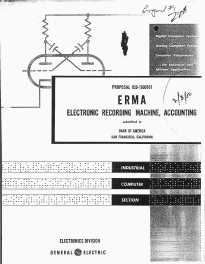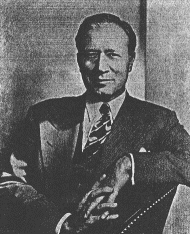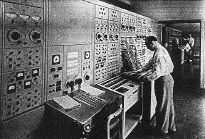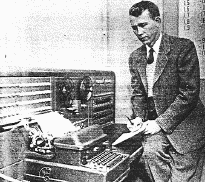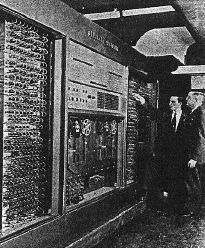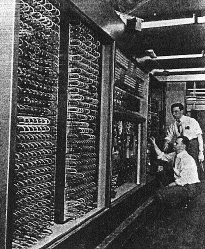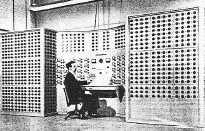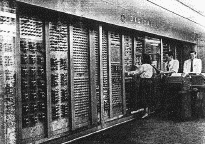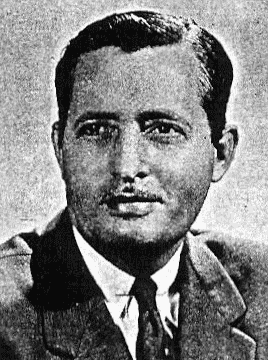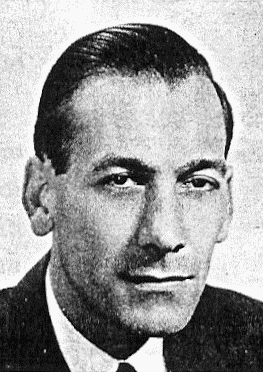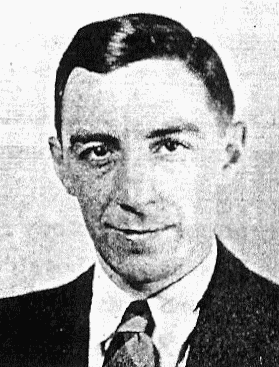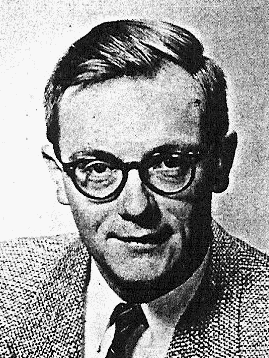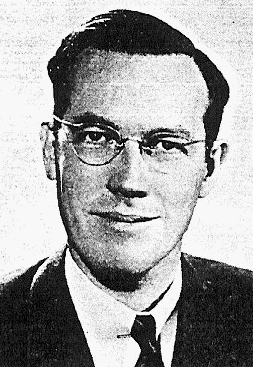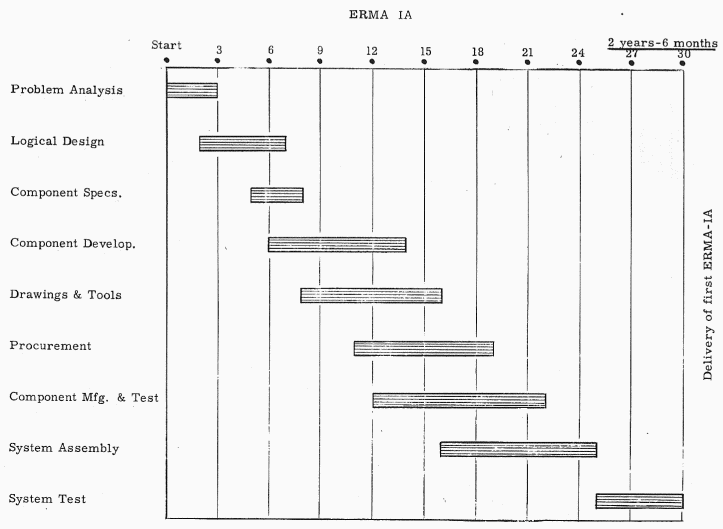|
INDUSTRIAL COMPUTERS SECTION
|
|||
|
PROPOSAL ICB 1100101 ERMA ELECTRONIC RECORDING MACHINE, ACCOUNTING
|
|||
|
FEBRUARY 3, 1956
|
|||
|
PROPOSAL ICB-1100101 E R M A ELECTRONIC RECORDING MACHINE, ACCOUNTING
|
|||
|
|
|||
|
Electronic computers are playing an increasingly important part in this age of automation. Recognition of this fact by the General Electric Company was reflected in a speech on Automation presented by Mr. Ralph J. Cordiner. President of General Electric, before a Congressional Committee in Washington, D.C., October 26, 1955. Mr. Cordiner closed his speech with the following:
|
|||
|
|
To sum up: 1. The computer is an important invention which extends the capacity of the human mind. 2. The computer is essential to our national defense, and in the advanced design of military equipment. 3. The computer will help business to produce better products at lower cost. 4. By providing better and more timely information for management, the computer will help to improve the stability of employment through better planning. 5. The computer-derived technologies will create new products and new industries which will be major sources of new employment in the coming years
|
||
|
SUMMARY
The purpose of this exhibit is to outline our proposed method of approach in converting the "research model" ERMA system into a well engineered and soundly manufactured product. This product will be first installed by the Bank of America. but will also be manufactured for and aggressively marketed to other banks throughout the country. Conversations with both the Bank of America and Stanford Research Institute personnel have firmly established the basic philosophy on which this program must be based. To take advantage of recent technological advances. and to insure that the initial ERMA represents an economically sound system. the first production ERMA, should represent a substantial step forward from the research model in terms of packaging and product design. though it will not incorporate any major changes in computer or system logic. This means. in particular. the design and utilization of transistor circuitry wherever applicable. It means also the use of a host of circuit design innovations aimed at reducing cost and improving reliability. In prosecuting this program we propose to move our computer engineering group into Stanford Research Institute quarters at once. and to work with their engineers in establishing a firm system specification calling for the maximum possible degree of modernization. The degree of improvement to be incorporated in ERMA IA is primarily a matter of time and cost. We have endeavored to measure these factors and to specify ERMAs that are not only highly useful devices for the Bank of America. but which are also marketable to other banks. This conception will be refined and sharpened by intensive study to be initiated immediately. In addition to producing modernized ERMAs from the onset. we will conduct a continuing program to develop improvements and modifications of the system as new techniques and methods permit. As appropriate. -1
|
|||
|
such improvements will be incorporated into the production line equipments and in many cases# retrofit kits will be made available for incorporation in earlier production models. By these means, ERMA IA can evolve into an even more economical and modern system. and need not fear early obsolescence. If this course is followed# there need be no abrupt transition to an ERMA II system over the next several years. Nevertheless. with the continued cooperation of Stanford Research Institute# we Will conduct research and advanced development aimed at major and fundamental improvements in system philosophy and implementation, and will Insure that both we and the Bank of America .maintain a commanding lead overall competition in this field. To the General Electric Company, ERMA does not merely represent a product to be built and marketed over the next four to five years. It will be a continuing and long-term product line of our organization. As such, its continued advancement will benefit continuously from the output of the thousands of scientists and engineers in our famous Research Laboratory and our many Division laboratories. This is the truest guarantee which We can make of the long range success of the program. -2
|
|||
|
ERMA IA AND MODERNIZATION PROGRAM
As in any technical development, the construction of ERMA I has shown the way to an improved machine having definite advantages over the original. This machine, termed ERMA IA in this proposal, will be the result of substantial design improvements. The primary objectives of this design will be the reduction of initial cost of the machine, the reduction of operating cost and improved reliability and ease of maintenance. Additional benefit~ which may be expected are an increase in the number of accounts handled by each equipment and the incorporation of several additional routines. The following section described some of the detailed considerations which will guide the design of ERMA IA. The various design features described are obviously tentative, inasmuch as they cannot be firmly specified either by Stanford Research Institute or ourselves until after check-out of ERMA I and mutual study of cost and time considerations. Nevertheless, they do represent our planned method of approach.
Basic Considerations The design of ERMA I attempts to satisfy the requirements of the check handling problem of the Bank of America by allowing several logical processes to occur simultaneously in the machine. This design allows the use of fairly slow clock frequencies and components, including a large amount of relay switching in the logical paths themselves. An alternative is to increase the speed of operation and reduce the number of parallel operations taking place in the computer. The General Electric Company believes that the proper compromise is toward higher speed, with a reduced complement of equipment result in fro fewer simultaneous logical paths. The higher speeds result in the replacement of substantial portions of the relay switching circuits by electronic units using semi-conductor -3-
or magnetic elements. These have proven records of reliability and exceed in this, respect the electro-mechanical devices employed in ERMA I. The use of these newer devices in the logical and arithmetic portions of the ERMA IA computer would reduce or even substantially eliminate the present complement of vacuum tubes. Magnetic elements and semi-conductor devices such as transistors will be considered in more detail below. A higher speed of operation will allow the use of other schemes to reduce the complexity of ERMA IA. One of these is increased use of built-in function tables for sequencing the logical operations and arithmetic procedures. Alternatively. program sequences stored on a small auxiliary drum or tape unit may prove to be more economical. In either case the logical complexity of the ERMA IA equipments will be reduced. Additional benefits from this approach include the provision of multiplication in the arithmetic internal orders of the machine. This would make feasible such routines as service charge computation based on average minimum balance.
Detailed Considerations Data Input The character sensing equipment developed by Stanford Research Institute is an important advance in the art. and appears to be exceptionally reliable and satisfactory. Maximum use should be made of this equipment in reducing the operator load. The entry of account number by automatic means is in process for ERMA I. This should be retained for ERMA but in addition the amount should be coded at previous verification stations and also entered into ERMA IA by character sensing. The keyboard layout may well be subjected to minor modifications. mechanical design presently used should be replaced by a simpler -4
|
|||
|
structure and the necessary verification operations done within the computer. Whether this will be feasible can only be determined by study. As an example of the type of solution which may be satisfactory, simple pushbars for manual entry may be combined with avisual operator display, to show the operator what is entered without automatic pulldown mechanisms. Means for loopcheck on all entries must be preserved under such a mode of operation.
The Use of Drums Drums are employed in ERMA I to store input data and to provide rapid determination of overdrafts, stop-payments etc. The two large drums and their associated equipment form an expensive portion of the overall machine. The determination of overdrafts could be made from the account tapes" but 'this would delay recognition of this condition until the end of the current run. In extreme cases overdrafts might not be detected until the end of the business day. The advantage of such a procedure would be to reduce the requirement to perhaps one drum" or permit the elimination of drums entirely. The latter would also be desirable from a maintenance standpoint. At present, drums on ERMA I are run 24 hours a day to prevent mechanical damage due to thermal contraction. While resigned drums may avoid this" they remain an item of expense and concern. Methods for reducing the detection time for overdrafts" etc. to an acceptable value" while eliminating the drums entirely will be considered for the design of ERMA IA. One such method is described in the next section. The Use of Tape Loops
The account tapes on ERMA I contain the basic record data in the -5
|
|||
| ordered sequence of account numbers. They
are brought up-to-date from the drums. If the balance information were not
retained on the drums, overdrafts would not be detected until the account
tapes are revised. Ideally each item should be filed on the account tapes
as received, but this is not feasible due to the search time. It would be
possible to revise the account tapes continuously from a circulating tape
loop containing ordered entries, and capable of storing at least
v one item per account number. If this loop is capable of one complete' pass during a time satisfactory for overdraft detection, a drumless system may be built. It appears feasible to detect overdrafts within about four minutes. which should be satisfactory. The four minute loop will be buffered to the input station by a shorter loop, of the order of one second per pass. The function of this loop is to store incoming entries so that they may be inserted in ordered fashion on the four minute loop: .The system just described would assure final disposition of incoming checks within about four minutes. It would completely eliminate magnetic drums, and replace these by reliable tape drives in case of breakdown of the tape units the four-minute tape may be placed on a spare and operation resumed. No corresponding measure is available for drums, as the latter are too expensive to allow for spares. The system is potentially capable of being loop-checked at every transfer, and should thus be reliable.The use of tape loops or other means for reducing or eliminating drums appears to promise reduction of cost and complexity. Various systems will be studied and the best incorporated in ERMA IA. The Use of Transistors Transistors and other solid state devices such as diodes are potentially capable of replacing vacuum tubes in the design of computers. The General Electric Company has been a leader in the development and - 6-
|
|||
|
(page 7 seems not to be present in this copy nor at CBI either... -Editor- EAS) -7-
|
|||
| reliability of magnetic elements greatly
exceeds that available from the best tubes or transistors. Their use in an
accounting data processing system is thus very appropriate.
The General Electric Company through its metallurgical activities has been a leader in the development of magnetic materials. The Company is in the enviable position of being able to formulate and produce magnetic materials to its own specifications in its own specialized production facilities at Syracuse and Schenectady, New York. Its grain oriented steels exceed in performance the best available from other sources and it is engaged in the manufacture of ferrite materials of the required properties for computer components. These developments will directly benefit the design program for ERMA IA..Magnetic cores may be used in the arithmetic, logical and storage sections of digital computers. The first two uses are directly applicable to ERMA IA and the vacuum tube and transistor requirements may be greatly reduced, while increasing the reliability of the remaining components. In the storage section the cost of ferrite core storage exceeds that of magnetic tape by a considerable margin, and the use of cores for storage is justified only in high-speed access memories which are not required for ERMA IA. It is the opinion of the General Electric Company that the most economical and reliable design for ERMA IA. will rely heavily on magnetic cores and transistors, and will contain a minimum of vacuum tubes. The complete elimination of the latter is not considered economical or necessary" providing their number will be in the hundreds instead of the thousands. The Use of Accuracy Checks Within ERMA The logical design of ERMA I makes considerable use of loop and parity checks upon internal transfer of information. This valuable feature - 8 -
|
|||
| of the design must be retained at all costs
in an accounting machine. Additional checks, such as in the arithmetic
units themselves, may well be advisable in ERMA IA. This is particularly
true if multiplication and division are to be incorporated from stored
programs. This would permit incorporation of a reliable service charge
computation based on average minimum balance. Overdrafts as a result of
service charges could also be detected at slight reduction in simplicity.
The programming counters used in ERMA I now operate without check, so that a miscount in the logical progression could occur. Checks on these counters appear to be advisable. In any case the use of stored programs and reduction of parallel operations will reduce the work load on these counters, further reducing them as a source of errors.At present three different codes are used in ERMA I. They are employed in arithmetic and transfer, teletype data loading and magnetic tape sections respectively. Considerable simplification and economics might be derived from choosing a common code applicable in all sections of ERMA IA. Code conversions would be minimized and the logical units standardized to a greater extent. This problem merits serious attention in the design of ERMA IA.- 9 -
|
|||
| PROGRAM
As will be recognized from the foregoing, advances in the art of computer design since the inception of the ERMA program promise an improved ERMA IA of lower cost, and exhibiting high degrees of reliability and ease of maintenance. To achieve these results as quickly as possible, we propose the following: 1. Assign G. E. computer engineering personnel to the Mark I systems test, and the Mark LA systems design immediately. 2. Establish an engineering facility at Stanford Research Institute, adjacent to the Mark I engineering building. 3. Start construction, at General Electric expense, of an additional wing to the General Electric Microwave Laboratory in Palo Alto. This space would be available some nine months after program start as the headquarters for the ERMA engineering, final assembly, and system test. Component construction and assembly will take place in our extensive Electronics Park facility.4. Engage the services of the Stanford Research Institute. 5. Engage a number of the Stanford Research Institute technical people on our payroll when appropriate, and per orderly arrangement with Stanford Research Institute. 6. Direct the fundamental research and development work in General Electric Laboratories to areas which will be applicable to future ERMA computers. Our manufacturing facilities, wherein we are most expert in electronic work, are more than adequate to meet any foreseeable requirements. - 10 -
|
|||
| We have major competence in the
establishment of new facilities to meet a particular situation, as is
indicated for this project. We plan to combine these in the most efficient
manner by producing the electronic units in our Syracuse plant, which is
equipped with up-to-date facilities and machines for this work, and which
can build such equipment economically and rapidly.
In order to minimize transportation costs, to promote liaison between the engineering group and the product, and to facilitate training for the rather large number of service people required, we plan to assemble and systems test ERMA equipment at the Computer System facility of the General Electric Microwave Laboratory, Palo Alto, California. We will install and check-out all equipments at sites to be specified by the Bank of America. While we understand that the customer will be able to provide his own maintenance personnel, other banks will undoubtedly require maintenance service from us, thus making it essential for General Electric to establish a training course for its own people. This same course would obviously be available for the training of Bank of America personnel.- 11 -
|
|||
|
page 12 is missing! Does anyone have a copy of this page? Email us at: info@smecc.org
|
|||
| 14. Electronic packages,
quantity undetermined at present.
15. Relay packages, quantity undetermined at present. 16. Racks and covers for electronic packages and relay packages. 17. Inter-connection wiring as necessary between racks and other equipment. 18. Instruction service and maintenance manual, quantity of 3. - 13 -
|
|||
| pic sheet 1\
Although our research and development effort in the computer field has been largely special purpose military work in the past, it is most logical that we now enter aggressively into the commercial field of special purpose computers. We have been conducting intensive marketing studies over the past two years to determine our most logical type of products, and time of entry into this field. These and other studies culminated the latter part of last year in the formation of the Industrial Computer Section of the Electronics Division. |
|||
| pic sheet 2
The General Electric Company has, for a number of years, been active in the computer field. Development, design and production of both digital and analog computers have been done on a surprisingly large-scale basis. This work is little known to the country at large, however, because it has been conducted almost exclusively for the Department of Defense, usually on classified military contracts. Some of General Electric's work known to commercial circles includes our OARAC, OMIBAC, Jet Engine Power Control Simulator, Penalty Factor Computer, and others. |
|||
|
THE MANAGEMENT TEAM G-E INDUSTRIAL COMPUTER SECTION
|
|||
|
HOMER R. OLDFIELD, JR. General Manager |
CLAIR C. LASHER Manager - Marketing |
||
|
KENNETH R. GEISER Manager - Engineering |
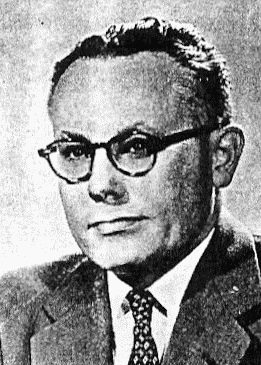
GEORGE C. TROTTER Manager - Sales |
||
|
CONSULTANTS G-E INDUSTRIAL COMPUTER SECTION
|
|||
|
ROBERT ROYCE JOHNSON University of Wisconsin, B. S. E. E. ; Yale University, M. Eng. E. E. ; California Institute of Technology, Ph. D. E. E.Experience: Yale University, design and construction of magnetic clutch lathe contour follower. . .. Hughes Aircraft Co., logical design of airborne digital computer; System and logical design of Hughes Business Data Processor; System design, airborne transistor control digital computer; Mathematical, logical and servo design of digitally controlled machine tool profiler . . .. California Institute of Technology, Design and construction of a special purpose digital computer to extract the complex roots of nth degree polynomials (Ph. D. thesis) . . .. Logical design of digital control and general purpose computers. . .. Digital servomechanisms . . .. Mathematical analysis. . .. Network synthesis. |
WILLIAM ALDEN EDSON University of Kansas, B. S., M. S. ; Harvard University, D. Sc.Experience: staff member, Bell Telephone Laboratories. . .. teaching staff, Illinois Institute of Technology. . . . Director, School of Electrical Engineering, Georgia Institute of Technology. . . . staff, Stanford Electronics Research Laboratory. . . . Acting Professor, E. E., Stanford University. . . . Chairman, Subpanel on Frequency Control of Research and Development Board, Consultant, United States Bureau of Standards. . .. research, microwave tubes, microwave circuits. . .. vacuum tube oscillators.
|
||
|
Delivery of First ERMA-IA
ERMA IA - Problem Analysis - Logical Design - Component Specs. - Component Develop. - Drawings & Tools - Procurement - Component Mfg. & Test - System Assembly - System Test
|
|||
|
ERMA ASSEMBLY & TEST - PALO ALTO -
CALIFORNIA
AVAILABLE LAB FACILITIES FOR ERMA - SHOP - PLATING - ELECTRO FORMING - PRECISION ASSEMBLY ELECTRONICS SHOP - PURCHASING - EMPLOYMENT OFFICES - ERMA ENGINEERING 2nd FLOOR - ERMA ENGINEERING 1st FLOOR - POWER SUPPLY- ERMA ASSEMBLY & TEST - SPECIAL SHOP FACILITIES - ERMA MAIN LAB BLDG. - MICROWAVE LAB
|
|||
|
Please email us if you have any other ERMA Information we can add to the site! |
|||
